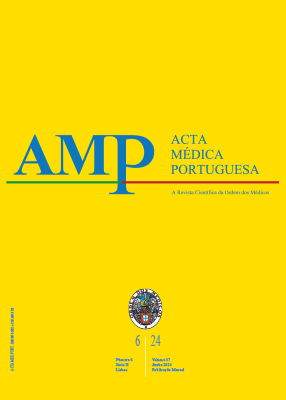Spinal Cord Stimulation in Refractory Postherpetic Neuralgia in Portugal: A Case Report
DOI:
https://doi.org/10.20344/amp.20524Keywords:
Neuralgia, Postherpetic/therapy, Pulsed Radiofrequency Treatment, Spinal Cord StimulationAbstract
Postherpetic neuralgia is one of the most severe complications after herpes zoster infection. Patients who experience persistent pain despite conservative treatment may benefit from interventional therapies, such as spinal cord stimulation. We present the case of a patient with severe refractory postherpetic neuralgia in the right T8 to L1 distribution who responded effectively to spinal cord stimulation. After its implantation, the patient had improvements in pain intensity, pain-related interference, quality of life, and satisfaction, with a simultaneous reduction of previous medications. This case report highlights the role of spinal cord stimulation in refractory neuropathic pain secondary to herpes zoster.
Downloads
References
Aaron S, Shawn K, Michael M, Rebecca L. Herpes zoster and postherpetic neuralgia: prevention and management. Essentials Pain Med. 2011;96:656-63.
Johnson RW, Rice AS. Postherpetic neuralgia. N Engl J Med. 2014;371:1526-33. DOI: https://doi.org/10.1056/NEJMcp1403062
Smith CA, Roman J, Mammis A. The role of spinal cord stimulation in reducing opioid use in the setting of chronic neuropathic pain: a systematic review. Clin J Pain. 2022;38:285-91. DOI: https://doi.org/10.1097/AJP.0000000000001021
Kiritsy MP, Siefferman JW. Spinal cord stimulation for intractable testicular pain: case report and review of the literature. Neuromodulation. 2016;19:889-92. DOI: https://doi.org/10.1111/ner.12487
Brandmeir NJ, Sather MD. Spinal cord stimulation for the treatment of neuropathic pain associated with leprosy: a case report. Neuromodulation. 2015;18:762-4. DOI: https://doi.org/10.1111/ner.12295
Williams DA. The importance of psychological assessment in chronic pain. Curr Opin Urol. 2013;23:554-9. DOI: https://doi.org/10.1097/MOU.0b013e3283652af1
Scholz J, Finnerup NB, Attal N, Aziz Q, Baron R, Bennett MI, et al. The IASP classification of chronic pain for ICD-11: chronic neuropathic pain. Pain. 2019;160:53-9. DOI: https://doi.org/10.1097/j.pain.0000000000001365
Finnerup NB, Attal N, Haroutounian S, McNicol E, Baron R, Dworkin RH, et al. Pharmacotherapy for neuropathic pain in adults: systematic review, metaanalysis and updated NeuPSig recommendations. Lancet Neurol. 2015;14:162-73. DOI: https://doi.org/10.1016/S1474-4422(14)70251-0
Lin CS, Lin YC, Lao HC, Chen CC. Interventional treatments for postherpetic neuralgia: a systematic review. Pain Physician. 2019;22:209-28. DOI: https://doi.org/10.36076/ppj/2019.22.209
Harke H, Gretenkort P, Ulrich Ladleif H, Koester P, Rahman S. Spinal cord stimulation in postherpetic neuralgia and in acute herpes zoster pain. Anesth Analg. 2002;94:694-700. DOI: https://doi.org/10.1097/00000539-200203000-00040
Liu B, Yang Y, Zhang Z, Wang H, Fan B, Sima L. Clinical study of spinal cord stimulation and pulsed radiofrequency for management of herpes zosterrelated pain persisting beyond acute phase in elderly patients. Pain Physician. 2020;23:263-70.
Oakley JC, Prager JP. Spinal cord stimulation: mechanisms of action. Spine. 2002;27:2574-83. DOI: https://doi.org/10.1097/00007632-200211150-00034
Kurklinsky S, Palmer SC, Arroliga MJ, Ghazi SM. Neuromodulation in postherpetic neuralgia: case reports and review of the literature. Pain Med. 2018;19:1237-44. DOI: https://doi.org/10.1093/pm/pnx175
Downloads
Published
How to Cite
Issue
Section
License
Copyright (c) 2024 Acta Médica Portuguesa

This work is licensed under a Creative Commons Attribution-NonCommercial 4.0 International License.
All the articles published in the AMP are open access and comply with the requirements of funding agencies or academic institutions. The AMP is governed by the terms of the Creative Commons ‘Attribution – Non-Commercial Use - (CC-BY-NC)’ license, regarding the use by third parties.
It is the author’s responsibility to obtain approval for the reproduction of figures, tables, etc. from other publications.
Upon acceptance of an article for publication, the authors will be asked to complete the ICMJE “Copyright Liability and Copyright Sharing Statement “(http://www.actamedicaportuguesa.com/info/AMP-NormasPublicacao.pdf) and the “Declaration of Potential Conflicts of Interest” (http:// www.icmje.org/conflicts-of-interest). An e-mail will be sent to the corresponding author to acknowledge receipt of the manuscript.
After publication, the authors are authorised to make their articles available in repositories of their institutions of origin, as long as they always mention where they were published and according to the Creative Commons license.









